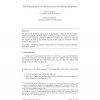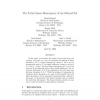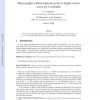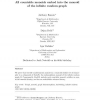DM
2010
13 years 9 months ago
2010
Jarik Nesetril suggested to the first author the investigation of notions of homogeneity for relational structures, where "isomorphism" is replaced by "homomorphism...
DM
2010
13 years 9 months ago
2010
We answer the following question of R. L. Graham: What is the discrepancy of the lexicographically-least binary de Bruijn sequence? Here, "discrepancy" refers to the max...
DM
2010
13 years 9 months ago
2010
DM
2010
13 years 9 months ago
2010
A 2-cover is a multiset of subsets of [n] := {1, 2, . . . , n} such that each element of [n] lies in exactly two of the subsets. A 2-cover is called proper if all of the subsets o...
DM
2010
13 years 9 months ago
2010
DM
2010
13 years 9 months ago
2010
We prove that every planar graph in which no i-cycle is adjacent to a j-cycle whenever 3 i j 7 is 3-colorable and pose some related problems on the 3-colorability of planar grap...
DM
2010
13 years 9 months ago
2010
DM
2010
13 years 9 months ago
2010
DM
2010
13 years 9 months ago
2010
The Grundy number of a graph G, denoted by (G), is the largest k such that G has a greedy k-colouring, that is a colouring with k colours obtained by applying the greedy algorithm...
DM
2010
13 years 9 months ago
2010
Given a metric d on a permutation group G, the corresponding weight problem is to decide whether there exists an element G such that d(, e) = k, for some given value k. Here we ...





